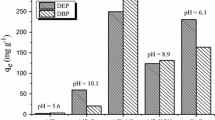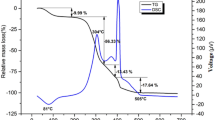Abstract
The adsorption of dibutyl phthalate (DBP) from aqueous solution using phoenix leaves activated carbon (PLAC) by chemical activation with phosphate was investigated. After scanning electron microscopy, energy dispersive X-ray spectrometry, Brunauer–Emmett–Teller (BET) and infrared spectrum characterization of PLAC, the influences of solution pH, contact time, initial DBP concentration and temperature on the adsorption rate were investigated. The isotherm, kinetic and thermodynamic parameters were explored to describe the experimental data. The PLAC has a heterogeneous distribution of grain and a well-developed porous structure. The main elements of PLAC are 24.26 % carbon, 70.65 % oxygen and 3.75 % phosphor. The BET surface area of the sample is 593.52 m2/g with the average pore diameter of 6.31 nm. The single-point total pore volume was found to be 0.52 cm3/g. The infrared spectrum showed the complexity of the material. The maximum DBP adsorption rate was 97.36 %, and the maximum adsorption capacity was 48.68 mg/g at pH 13. The monolayer sorption capacity of the biosorbent for DBP was found as 133.33 mg/g with the Langmuir isotherm. The equilibrium data fitted with Freundlich isotherm better than Langmuir, Dubinin–Radushkevich and Temkin isotherm. The kinetic data were best described by the pseudo-second-order model better than pseudo-first-order kinetic, intraparticle diffusion, and Elovich model. The thermodynamic studies indicated that the sorption process spontaneous, thermodynamically favorable and endothermic. The PLAC can be an alternative material for treatment of DBP wastewater.








Similar content being viewed by others
References
Ahmad A, Rafatullah M, Sulaiman O, Ibrahim MH, Hashim R (2009) Scavenging behaviour of meranti sawdust in the removal of methylene blue from aqueous solution. J Hazard Mater 170(1):357–365
Behera SK, Oh SY, Park HS (2012) Sorptive removal of ibuprofen from water using selected soil minerals and activated carbon. Int J Environ Sci Technol 9(1):85–94
Carvalho AP, Cardoso B, Pires J, de Carvalho MB (2003) Preparation of activated carbons from cork waste by chemical activation with KOH. Carbon 41(14):2873–2876
Cerino-Cordova FJ, Diaz-Flores PE, Garcia-Reyes RB, Soto-Regalado E, Gomez-Gonzalez R, Garza-Gonzalez MT, Bustamante-Alcantara E (2013) Biosorption of Cu(II) and Pb(II) from aqueous solutions by chemically modified spent coffee grains. Int J Environ Sci Technol 10(3):611–622
Chang BV, Lu YS, Yuan SY, Tsao TM, Wang MK (2009) Biodegradation of phthalate esters in compost-amended soil. Chemosphere 74(6):873–877
Chen CY, Chen CC, Chung YC (2007) Removal of phthalate esters by alpha-cyclodextrin-linked chitosan bead. Bioresour Technol 98(13):2578–2583
Chi JE, Yang Q (2012) Effects of Potamogeton crispus L. on the fate of phthalic acid esters in an aquatic microcosm. Water Res 46(8):2570–2578
Crini G (2005) Recent developments in polysaccharide-based materials used as adsorbents in wastewater treatment. Prog Polym Sci 30(1):38–70
Deniz F, Karaman S (2011) Removal of Basic Red 46 dye from aqueous solution by pine tree leaves. Chem Eng J 170(1):67–74
Dubey A, Shiwani S (2012) Adsorption of lead using a new green material obtained from Portulaca plant. Int J Environ Sci Technol 9(1):15–20
Fang ZQ, Huang HJ (2009) Adsorption of di-n-butyl phthalate onto nutshell-based activated carbon. Equilibrium, kinetics and thermodynamics. Adsorpt Sci Technol 27(7):685–700
Fang HHP, Zheng HH (2004) Adsorption of phthalates by activated sludge and its biopolymers. Environ Technol 25(7):757–761
Fang CR, Long YY, Shen DS (2009) Comparison on the removal of phthalic acid diesters in a bioreactor landfill and a conventional landfill. Bioresour Technol 100(23):5664–5670
Fang CR, Yao J, Zheng YG, Jiang CJ, Hu LF, Wu YY, Shen DS (2010) Dibutyl phthalate degradation by Enterobacter sp T5 isolated from municipal solid waste in landfill bioreactor. Int Biodeter Biodegr 64(6):442–446
Han XL, Wang W, Ma XJ (2011) Adsorption characteristics of methylene blue onto low cost biomass material lotus leaf. Chem Eng J 171(1):1–8
Health Ministry of People’s Republic of China (2007) Standards for drinking water quality of China (GB5749–2006)
Jibril B, Houache O, Al-Maamari R, Al-Rashidi B (2008) Effects of H3PO4 and KOH in carbonization of lignocellulosic material. J Anal Appl Pyrolysis 83(2):151–156
Julinova M, Slavik R (2012) Removal of phthalates from aqueous solution by different adsorbents: a short review. J Environ Manage 94(1):13–24
Kumar A, Prasad B, Mishra IM (2008) Adsorptive removal of acrylonitrile by commercial grade activated carbon: kinetics, equilibrium and thermodynamics. J Hazard Mater 152(2):589–600
Kumar R, Jain SK, Misra RK, Kachchwaha M, Khatri PK (2012) Aqueous heavy metals removal by adsorption on beta-diketone-functionalized styrene-divinylbenzene copolymeric resin. Int J Environ Sci Technol 9(1):79–84
Lang W, Buranaboripan W, Wongchawalit J, Parakulsuksatid P, Vanichsriratana W, Sakairi N, Pathom-aree W, Sirisansaneeyakul S (2013) Biosorption of lead from acid solution using chitosan as a supporting material for spore forming-fungal biomass encapsulation. Int J Environ Sci Technol 10(3):579–590
Li LS, Zhu WP, Chen L, Zhang PY, Chen ZY (2005) Photocatalytic ozonation of dibutyl phthalate over TiO2 film. J Photoch Photobio A 175(2–3):172–177
Li HY, Qu JH, Liu HJ (2006) Removal of a type of endocrine disruptors-di-n-butyl phthalate from water by ozonation. J Environ Sci 18(5):845–851
Mehrizad A, Zare K, Aghaie H, Dastmalchi S (2012) Removal of 4-chloro-2-nitrophenol occurring in drug and pesticide waste by adsorption onto nano-titanium dioxide. Int J Environ Sci Technol 9(2):355–360
Mendez-Diaz JD, Daiem MMA, Rivera-Utrilla J, Sanchez-Polo M, Bautista-Toledo I (2012) Adsorption/bioadsorption of phthalic acid, an organic micropollutant present in landfill leachates, on activated carbons. J Colloid Interface Sci 369:358–365
Ooka C, Yoshida H, Suzuki K, Hattori T (2004) Highly hydrophobic TiO2 pillared clay for photocatalytic degradation of organic compounds in water. Micropor Mesopor Mat 67(2–3):143–150
Ozer ET, Osman B, Kara A, Besirli N, Gucer S, Sozeri H (2012) Removal of diethyl phthalate from aqueous phase using magnetic poly(EGDMA-VP) beads. J Hazard Mater 229:20–28
Qureshi UA, Solangi AR, Memon SQ, Taqvi SIH, Memon N (2012) Ionic liquid modified resin for the adsorptive removal of dibutyl phthalate: equilibrium, kinetic, and thermodynamic studies. Clean-Soil Air Water 40(6):630–639
Ranganathan K (2000) Chromium removal by activated carbons prepared from Casurina equisetifolia leaves. Bioresour Technol 73(2):99–103
Ren YM, Dong Q, Feng J, Ma J, Wen Q, Zhang ML (2012) Magnetic porous ferrospinel NiFe2O4: a novel ozonation catalyst with strong catalytic property for degradation of di-n-butyl phthalate and convenient separation from water. J Colloid Interface Sci 382:90–96
Salim CJ, Liu H, Kennedy JF (2010) Comparative study of the adsorption on chitosan beads of phthalate esters and their degradation products. Carbohyd Polym 81(3):640–644
Shaikh H, Memon N, Khan H, Bhanger MI, Nizamani SM (2012) Preparation and characterization of molecularly imprinted polymer for di (2-ethylhexyl) phthalate: application to sample clean-up prior to gas chromatographic determination. J Chromatogr A 1247:125–133
Xu XR, Li XY (2008) Adsorption behaviour of dibutyl phthalate on marine sediments. Mar Pollut Bull 57(6–12):403–408
Zhang P, Ren BZ (2013) Inverse emulsion polymerization of dimethyl diallyl ammonium chloride and acrylamide for water treatment. Asian J Chem 25(7):3966–3970
Acknowledgments
The authors express their sincere gratitude to the Natural Science Foundation of the Jiangsu Higher Education Institutions of China (12KJB560004), Housing and Urban and Rural Construction Technology Program of Ministry of Science and Project (2011-K7-2), the project of Jiangsu government scholarship for study abroad (2012196) and A Project Funded by the Priority Academic Program Development of Jiangsu Higher Education Institutions (PAPD) for financial support.
Author information
Authors and Affiliations
Corresponding author
Rights and permissions
About this article
Cite this article
Wang, Z. Efficient adsorption of dibutyl phthalate from aqueous solution by activated carbon developed from phoenix leaves. Int. J. Environ. Sci. Technol. 12, 1923–1932 (2015). https://doi.org/10.1007/s13762-014-0554-7
Received:
Revised:
Accepted:
Published:
Issue Date:
DOI: https://doi.org/10.1007/s13762-014-0554-7




